Abstract
The current study is an attempt to analytically characterize the second law analysis and mixed convective rheology of the (Al2O3–Ag/H2O) hybrid nanofluid flow influenced by magnetic induction effects towards a stretching sheet. Viscous dissipation and internal heat generation effects are encountered in the analysis as well. The mathematical model of partial differential equations is fabricated by employing boundary-layer approximation. The transformed system of nonlinear ordinary differential equations is solved using the homotopy analysis method. The entropy generation number is formulated in terms of fluid friction, heat transfer and Joule heating. The effects of dimensionless parameters on flow variables and entropy generation number are examined using graphs and tables. Further, the convergence of HAM solutions is examined in terms of defined physical quantities up to 20th iterations, and confirmed. It is observed that large upgrades velocity, entropy generation and heat transfer rate, and drops the temperature. High values of enlarge velocity and temperature while reducing heat transport and entropy generation number. Viscous dissipation strongly influences an increase in flow and heat transfer rate caused by a no-slip condition on the sheet.
1. Introduction
The major factors subject to the efficiency of the heat transfer processes include structure, control, and analysis of thermal systems. Evidently, fluids dominantly grow the flow and rate of heat transfer corresponding to the applications in engineering and scientific systems including efficient heat surface area, microscale cooling devices, vibration of heated surfaces, and microelectronic devices etc. In order to get more efficient results, there have been a lot of attempts by researchers to synthesize these fluids for an amplified heat transfer rate, using the composition of several fluids as well as the dispersion of metallic particles of different sizes and shapes etc. The efficient thermal characteristics of nanofluids, colloidal suspensions of nanoparticles in base fluids primarily prepared by Choi [1], were guaranteed due to their substantially modified thermal conductivities with insignificant abrasion. Since then, investigators have conducted various theoretical and experimental studies, and some are mentioned here [2,3,4,5,6,7,8]. In order to acquire the highest composite thermal features, hybrid nanofluids are synthesized by imbedding the nanoparticles of several materials into conventional fluids that possess improved physical and chemical properties in a homogeneous phase. In this regime, Iqbal et al. [9] demonstrated the thermal characteristics of the MHD (Cu–CuO/water) hybrid nanofluid in rotating flow through an oscillatory vertical conduit by considering the influences of Hall current and thermal radiation. Awais et al. [10] examined the peristaltic transport of rheological hybrid nanofluid for the power-law model due to cilia motion, and encountered the impact of magnetic induction as well. They illustrated that nanoparticles’ coating perks up peristaltic pumping and heat transfer properties, which are important to use in endoscopy and cancer therapy. Ali et al. [11] explored MHD peristalsis of the TiO2–Cu/H2O hybrid nanofluid by taking the non-Newtonian Jeffrey model with wall slip conditions. Recently, Abbas et al. [12] studied an extension of the rheological hybrid nanofluid models, named as the Yamada–Ota and Xue models, for flow over a moving needle. Parveen et al. [13] utilized computational intelligence techniques in order to estimate the pressure rise and rate of heat transfer in the dynamics of the hybrid nanofluid under magnetic induction effects in endoscopy. It was revealed that heat transfer coefficient enhancements towards the Br and χ. neural network algorithm were employed in order to validate the experimental data, and very accurate results were obtained. Lund et al. [14] established a study for finding multiple solutions for MHD (Cu–Fe3O4/H2O) hybrid nanofluid dynamics, which occurred due to a variable stretching/shrinking surface. The research community have been using hybrid nanomaterials in diverse applications with the aim to get efficient thermal systems with little nanoparticles’ volume fraction at a minor cost of production, and some of this literature is presented in [15,16,17]. Further, metal oxides show excellent chemical inertness and they are stable. Alumina (Al2O3) is preferred to study here, owing to its validity in the improvement of ceramic density, smoothness, fracture toughness, in refractory products and as an ideal material of far-infrared emission. Its potential applications are attributed to its abrasiveness, enhanced hardness, chemical inertness, stability, strong emission, absorbance spectra and high properties of electrical and thermal insulation. However, Al2O3 possesses small fracture resistance and is flammable, so its use as a structural material is hindered. While metallic nanoparticles possess unique optoelectrical properties, are inflammable as well as high thermal and electrical conductivities [18,19,20]. Therefore, Al2O3–Ag/H2O is studied in present work.
Boundary-layer flows combined with heat transfer and followed by a stretching sheet, as primarily proposed by Sakiadis [21], has become a field of curiosity for scientists and researchers owing to its incredible technological and industrial utilizations, including the manufacturing of materials by extrusion procedures and heat tampered materials flowing inside a wind-up roll possessing the features of moving continuous sheets. Moreover, viscous dissipation effects are dominant in strong gravitational fields. Viscous dissipation and heat generation in mixed convective boundary-layer flow play a vital role in different fields such as chemical, mechanical, and aerospace engineering. Karwe and Jaluria [22] analyzed fluid transport with mixed convection over a moving plate in procedures like rolling and extrusion. Awais et al. [23] inspected the effects of heat generation/absorption in a boundary-layer flow of Maxwell nanofluid by adopting numerical and analytical techniques. Wang et al. [24] studied the effects of radiative heat flux with heat generation/absorption in homogeneous–heterogeneous catalytic reactions of Oldroyd-B fluid. Sharma et al. [25] numerically analyzed fractional boundary-layer flow due to a stretching sheet of non-uniform thickness with the help of a finite-difference approach. Khan et al. [26] explored heat and mass transfer analysis in three-dimensional nanofluids flowing on a linear stretching sheet under convective wall conditions. Further, magnetic field effects in boundary-layer flow, with heat transport of electrically conducting fluids, have plausible applications in several industrial contexts involving the continual stretching of artificial fibers, plastic films, and the spinning of metals etc. The study of interactions between electrically conducting fluids and a magnetic field was named magnetohydrodynamics (MHD) by Alfven [27]. Physically, external magnetic fields generate an electric current in a flowing electrically conducting fluid, which polarizes the fluid due to the changing magnetic flux. Awais et al. [28] carried out heat and mass transfer analysis for Casson fluid flow through a porous medium on a shrinking wall associated with the effects of heat source/sink and Lorentz force. Irfan et al. [29] introduced a new computational technique designed for EMHD nanofluid dynamics over a non-uniform surface with variable liquid characteristics. Awais et al. [30] scrutinized the influence of temperature-dependent transport properties on the rate of heat and mass transfer in MHD bioconvection nanofluid rheology suspended by gyrotactic microorganisms using a numerical technique. Magnetic induction effects are negligible in the case of large magnetic diffusion. However, the phenomenon is significant with the dynamical conductive fluid, which advects the flux lines of the magnetic field so the magnetic Reynolds number becomes countable. The induction of MHD is imperative to amplify the flow fields in a preferable direction by changing the boundary-layer structure. In order to understand the flow mechanism under magnetic induction effects, several attempts have been made [31,32,33,34,35].
In thermodynamical investigations of flow and heat transfer processes, including complicated physiological structures, spin moment, and inertial displacement of particles, a major issue is to improve the efficiency of thermal systems to reduce heat loss, which is a quantitative measure called entropy generation. Khan et al. [36] investigated the significance of Al2O3–H2O and γ-Al2O3–C2H6O2 nanomaterials in Darcy-Forchheimer stagnation point flow with entropy optimization. Mumraiz et al. [37] established the analysis of entropy generation in the transport of electrical MHD (Al2O3–Cu/H2O) hybrid nanofluid in the presence of variable heat flux. Ali et al. [38] studied entropy optimization in the MHD peristaltic transport of Cu–water nanofluid under the effects of wall slip conditions. Awan et al. [39] numerically analyzed entropy optimization and magnetic induction effects on the ciliary-induced peristaltic transport of hybrid nanomaterials. It was ensured that the thermal performance of the fluid could be boosted by utilizing the hybrid nanomaterial strength of the wall for stability. The irreversibility analysis ensures that entropy is reduced for a strong magnetic field. Sahoo et al. [40] carried out the analysis of entropy optimization, with dissipative heat transfer, in mixed convective MHD Casson nanofluid flow under the effects of Hall current and thermal radiation.
In view of the above-mentioned literature, the boundary-layer flow of hybrid nanofluid influenced by an induced magnetic field over a stretching sheet for entropy generation and heat transfer analysis under the effects of mixed convection, heat generation, and viscous dissipation, has not yet been investigated. The present study is an extension of the work of Iqbal et al. [41]. Furthermore, this study is concerned with analytical solutions using the homotopy analysis method (HAM) as well. The behavior of the flow profiles and entropy generation number against the involved parameters is exposed graphically, and the results for skin friction and Nusselt number have been computed and demonstrated.
2. Problem Development
Consider the mixed convection boundary-layer flow of Newtonian (Al2O3–Ag/H2O) hybrid nanofluid over an impermeable linearly stretchable sheet. The sheet velocity is and the ambient velocity of the fluid is , in which a and c denote positive constants. The temperature of the sheet and free stream are represented as , accordingly. Furthermore, the influence of magnetic induction is encountered where the magnetic field at free stream is denoted as . The geometrical interpretation of this circumstance is given in Figure 1.
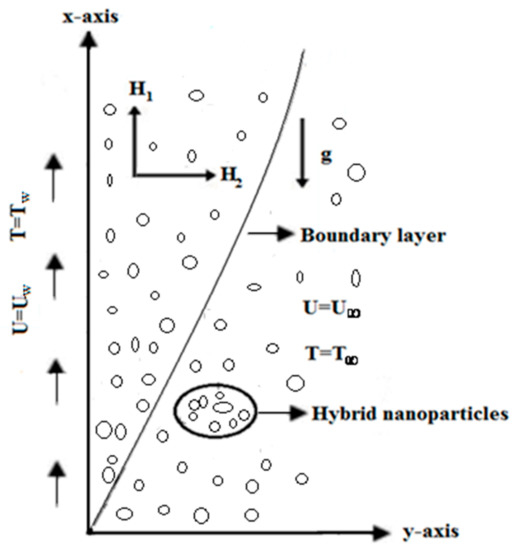
Figure 1.
Geometrical interpretation of the problem.
The vector form of the governing model is given here. The continuity equations for velocity and magnetic induction are as follows:
The equation for the conservation of momentum and induced magnetic field are as follows:
The equation for the conservation of energy is as follows:
In the above model, V, H and T express the variables of the velocity field, induced magnetic field and temperature, while I represents the identity matrix, and p is the fluid pressure. Moreover, ,, Q, and g denote the magnetic permeability, magnetic diffusivity, heat generation/absorption parameter, and gravitational acceleration. The expressions for the Cauchy stress tensor and viscous dissipation function for the Newtonian fluid are as follows:
In component form, the following applies:
The associated boundary conditions are as follows:
where and denote the x and y components of V and H, respectively. Further, the parameters involved are as follows:
For the (Al2O3–Ag/H2O) hybrid nanofluid are volume fractions, stand for the density, thermal expansion coefficient, specific heat at constant pressure and thermal conductivity, with the subscripts denoting properties of the fluid, nanofluid, hybrid nanofluid, solid nanoparticle of silver and alumina with s as the shape factor, respectively.
Invoking the following quantities for transformation of the partial differential equations with the similarity variable , we obtain the following:
We get the transformed set of differential equations as the following:
The transformed wall properties are as follows:
where the Prandtl number Pr, stretching ratio parameter , reciprocal of magnetic Prandtl number , magnetic parameter , Eckert number Ec, heat generation/absorption parameter and mixed convection parameter are expressed as the following:
The considerable physical quantities are the coefficient of skin friction and Nusselt number , which are expressed as the following:
In the above expressions, gives shear stress at the wall while denotes wall heat flux. The non-dimensional form with the help of similarity transformation is as follows:
where represents the local Reynolds number.
Entropy Analysis
The volumetric entropy generation rate () for the fluid, influenced by the induced magnetic field, can be expressed as follows:
where the terms on the right-hand side depict the entropy generation caused by heat transfer across the boundary layer, viscous dissipation and induced magnetic field, respectively. The characteristic entropy generation rate with the characteristic length L is as follows:
Hence, the dimensionless entropy generation rate by using Equation (18) and the similarity transformation in Equation (17) is as follows:
In which, is Reynolds number, and expresses temperature ratio parameter.
3. Solution Methodology and Convergence
3.1. Methodology
Boundary-layer flow over the stretching sheet, with induced magnetic field effects, is examined for characterizing the influence of mixed convective rheology, viscous dissipation, heat generation/absorption, and analysis of entropy generation. The dimensionless governing model mentioned in Equations (13)–(15) and the subjected boundary conditions of Equation (16) are analytically solved by employing the homotopy analysis method [42,43,44,45]. For flow variables, the initial guesses are , and the linear operators for respective variables are as follows:
Further,
where C1–C8 represent the constants in general solutions. Suppose h1, h2, and h3 are auxiliary parameters in the frame of HAM, which directly affect the convergence of solutions. Let be an embedding parameter then the problem for the zeroth-order deformation is constructed as the follows:
Further,
Using the above-mentioned quantities, the mth order solution series is constructed as the following:
In the above equations,
The subjected boundary conditions are as follows:
Then we can write,
The particular solutions , and are obtained using Mathematica ([10]), while the constants are determined from the defined boundary conditions.
3.2. Convergence of Solutions
The homotopy analysis method is adopted to solve the dimensionless model of differential equations, and a Mathematica code is constructed. In order to examine the accuracy and convergence of the HAM solutions, a convergence table is prepared for magnitudes of skin friction and Nusselt number up to approximately the 20th iterations (Table 1), which clearly fulfill the specified convergence criteria i.e., .

Table 1.
Convergence of HAM solutions.
4. Results and Discussion
In this section, the influences of important parameters on the flow variables and entropy generation number are exposed and discussed. Figure 2, Figure 3 and Figure 4 plot the variation in velocity () against the mixed convection parameter, Brinkman number and heat generation parameter. Figure 2 gives an increment in for an increasing magnitude of . This behavior occurred due to a large temperature gradient which led to high buoyancy effects and directly affected the convection in fluid. In fact, buoyancy force behaves as a favorable pressure gradient which drives the fluid, so the velocity and the boundary-layer thickness become larger. The dominant effect appears in the region near the sheet, which approaches the value of the velocity ratio at a distance far from the sheet. Here, negative and positive values of indicate the cooling and heating phenomenon of the fluid, respectively. According to the graph, a strong cooling effect corresponds to a decrease in the velocity, while a heating effect accelerates the flow. Figure 3 demonstrates an increment in for . The negative values of depict the heat absorption phenomenon, whereas the positive values correspond to heat generation. The graphical behavior shows that strong absorption effects at large negative values tend to decrease the fluid velocity, while increasing positive values regarding heat generation increase the velocity and thickness of its boundary layer. This is because, by definition of , the internal heat of fluid rises for a higher magnitude which directly enhances kinetic energy and thus fluid flow. Figure 4 plots against Br at Pr = 6.2. The increase in velocity boundary-layer thickness in the graph is because of the fact that large values of Br, by definition, lead to a high velocity of the stretching sheet. According to the no-slip wall condition, fluid velocity increases near the sheet but the effect is not very dominant due to viscous forces. These effects disappear in free stream where the flow is only affected due to the mixed convection and magnetic induction.
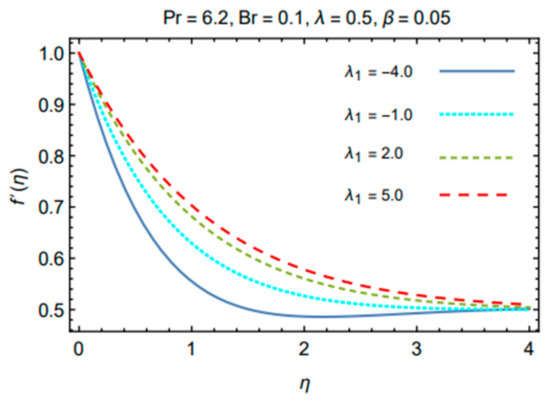
Figure 2.
Variation in against
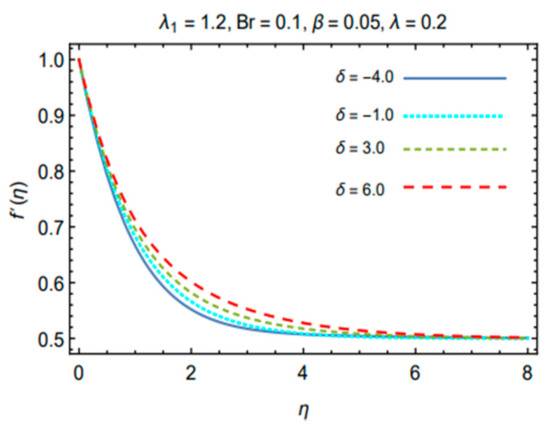
Figure 3.
Variation against
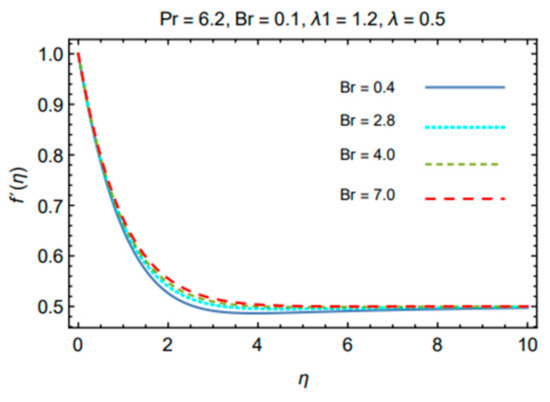
Figure 4.
Variation in against
Figure 5 explores the dual behavior of against . This graph presents a dominant increasing trend in , which gradually frails up to the inflation point where the parameter has no effect. This trend is due to the addition of a flow mechanism near the sheet. In the free-stream region, decreases and goes asymptotically to 1 as the values of rise. Similar behavior is noticed for both the assisting as well as opposing case.
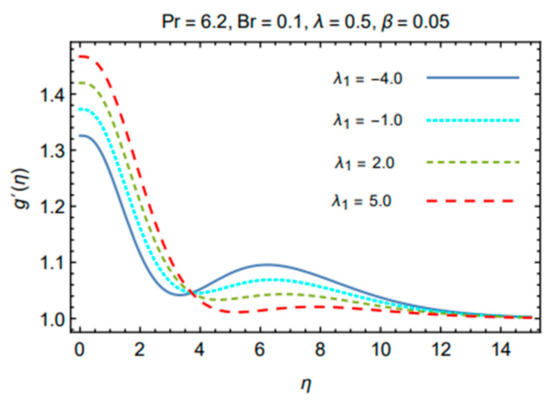
Figure 5.
Variation in against λ1.
The physical influence of dimensionless parameters on the temperature of the fluid is plotted in Figure 6 and Figure 7. The variation in the temperature field towards the growing values of is illustrated in Figure 6 which explores the decay in temperature. Physically, increasing the magnitude of corresponds to an increase in the temperature gradient and accelerates the flow due to gravity. These combined effects increase fluid velocity, and heat transfer rate increases which decreases the internal energy of the fluid. Moreover, high negative values of possess a higher ambient temperature, and the fluid temperature is high. The temperature profile for variation in is depicted in Figure 7. With an increase in the negative values from −0.2 to −0.4, the temperature of the fluid decreases absolutely due to high heat absorption. Contrary to this, an increase in the positive values show strong heat generation which enhances the fluid temperature as well as the thermal boundary-layer thickness according to the definition of heat generation.
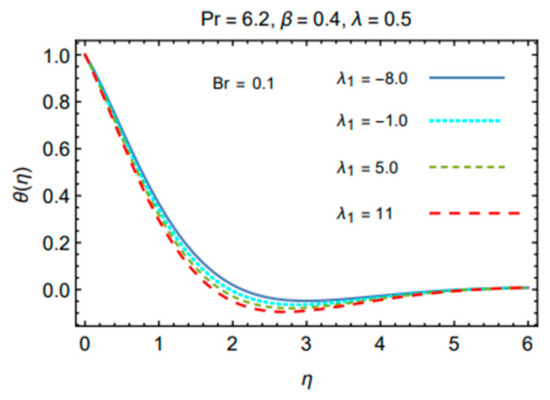
Figure 6.
Variation in against λ1.
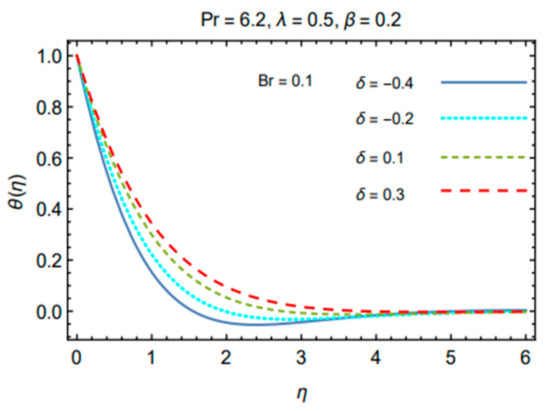
Figure 7.
Variation in against .
The variation in the entropy generation number (Ns) for the physical parameters is displayed graphically to understand the physical aspects of the work. The graph of Ns for increasing values of is presented in Figure 8, which shows an increase in entropy generation. Since entropy is directly affected by temperature gradient, which raises the flow and heat transfer rate, the results lead to a rise in entropy generation. Figure 9 depicts the variation in Ns against values of the Brinkman number which indicates an increase in Ns. The reason behind such behavior is that rising values of Br explore viscous effects in fluid due to the no-slip wall condition. This trend causes flow acceleration and an increase in entropy.
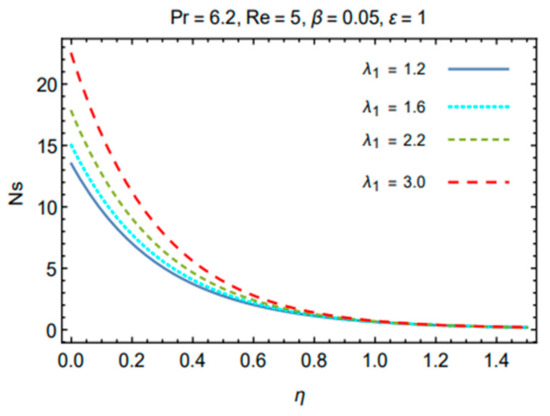
Figure 8.
Variation in Ns against
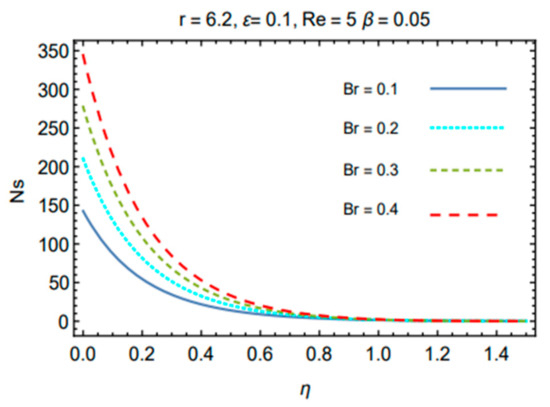
Figure 9.
Variation in Ns against Br.
The influence of temperature ratio parameter on Ns is explored in Figure 10. It presents that increasing values of yield high entropy due to the rising temperature gradient of the fluid. An enhancement in heat generation results in the rising of the internal energy and temperature of the fluid, and a decrease in kinetic energy which reduces heat transfer. Therefore, entropy in the system reduces. This fact is depicted in Figure 11. It is noticed from the graph of the entropy generation number, that the effect of involving the parameters and magnitudes of the entropy generation number is considerably close to the stretching sheet and less far from it. This trend is physically due to the strong viscous effects and temperature gradient near the wall.
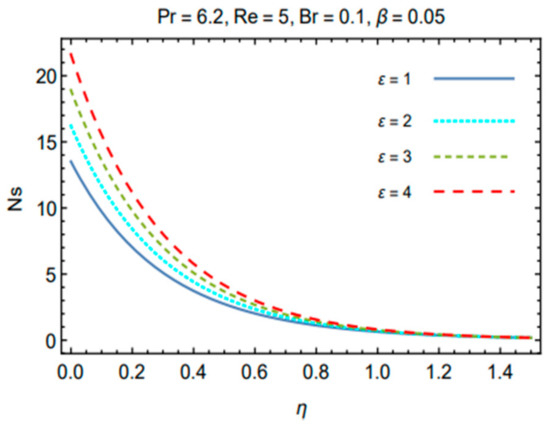
Figure 10.
Variation in Ns against
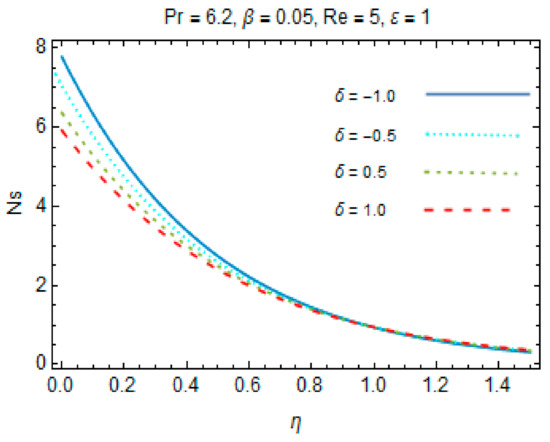
Figure 11.
Variation in Ns against
Table 2 represents the numerical values of the thermophysical quantities for the considered hybrid nanofluid. Moreover, Figure 12, Figure 13, Figure 14 and Figure 15 explore the bar-chart view of skin friction and Nusselt number against pertinent parameters. The influence of different nanoparticle shape factors, including bricks (s = 3.7), cylinders (s = 4.9) and platelets (s = 5.7), are investigated for heat transfer analysis. These numerical values are presented in Table 3 and Table 4 as well. Figure 12 reveals that Cf decreases for the opposing flow, corresponding to the negative values of when they change from −1 to −4. The opposite trend is explored for the positive values of Moreover, the effects of the magnetic parameter on show a decreasing behavior. The magnetic parameter gives the order of the ratio of magnetic energy and kinetic energy per unit volume, and with an increase in magnitude, flow rate decreases. An increase in temperature difference occurs for enhancing values of , which decreases shear effects. Also, a comparison of the Nusselt number with expansion in the shape factor of nanoparticles is presented, which illustrates that platelet-shaped nanoparticles have more contribution in enhancing thermal characteristics as compared to the others.

Table 2.
The experimental values of the thermophysical properties for the base fluid and nanomaterials [41].
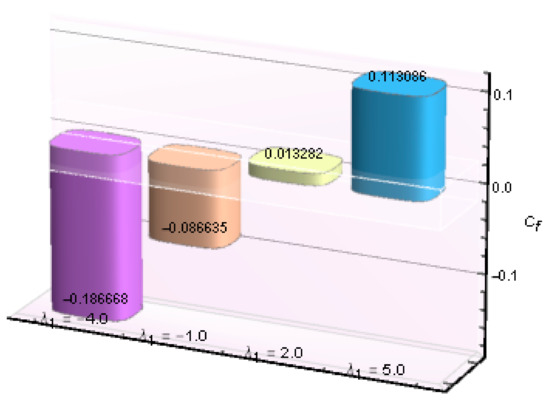
Figure 12.
Variation in Cf against
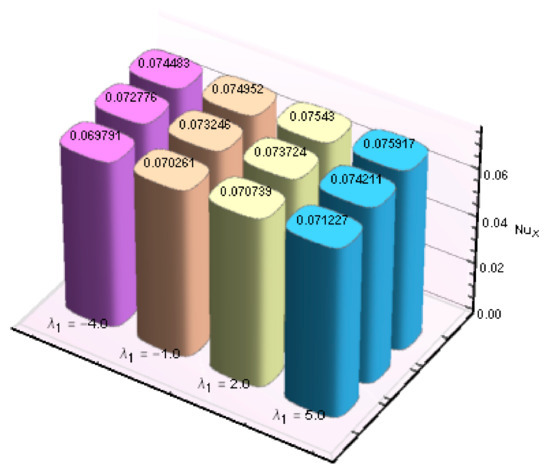
Figure 13.
Variation in Nux against
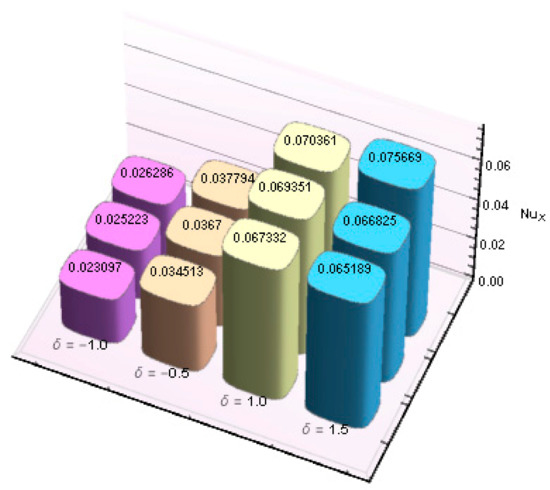
Figure 14.
Variation in Nux against .
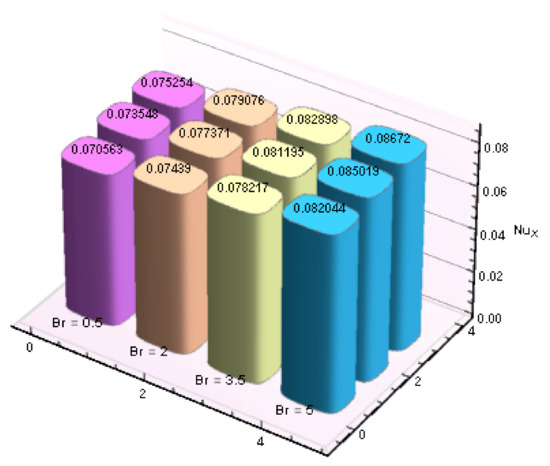
Figure 15.
Variation in Nux against .

Table 3.
The results for the skin friction coefficient of Al2O3–Ag/H2O against nondimensional parameters.

Table 4.
The results for the Nusselt number of Al2O3–Ag/H2O against nondimensional parameters.
Besides this, the results of the HAM solutions in the present study are compared with the numerical results presented in the work of Iqbal et al. [41]. The extended parameters are neglected i.e., in order to gain the model presented in Iqbal et al. [41]. The results of both studies are shown in Table 5 and Table 6. It is observed that the existing results are in good agreement with the previously published results.

Table 5.
A comparison of the present results of against with those of Iqbal et al. [41] when

Table 6.
A comparison of the present results of against with those of Iqbal et al. [41] when
5. Conclusions
The present work is an analytical attempt for the analysis of heat transfer and entropy generation in the dynamics of hybrid nanofluid, influenced by induced magnetic field under the influence of viscous dissipation, mixed convection and heat generation. The major consequences are as follows:
- The convergence of HAM solutions is ensured up to 20th iterations;
- The mixed convection parameter under magnetic induction effects rises in the case of assisting flow for positive magnitude, while it decreases for strong opposing behavior due to cooling of the sheet. Thus, assisting flow grows the flow and heat transfer rate;
- The heat generation parameter indicates growth of the velocity boundary-layer thickness for internal heat generation, while it reduces for heat absorption. Moreover, fluid velocity increases for high values of Brinkman number in the case when sheet velocity is larger than ambient velocity;
- The induced magnetic field profile shows a dominant increasing trend near the sheet for the mixed convection parameter, while it has a reverse behavior away from the sheet;
- The temperature of the fluid becomes high due to internal heat generation corresponding to positive δ, but decreases for heat absorption and mixed convection parameters due to cooling of the surface;
- The entropy generation number presented an increasing magnitude for large values of the mixed convection parameter, temperature ratio, and Brinkman number, while its values drop down for increasing internal heat generation. Large values of entropy generation number appear in the vicinity of the sheet due to high viscous effects and the no-slip wall condition;
- Moreover, the behavior of the Nusselt number for the shape factors depicts that platelet-shaped nanoparticles significantly enhance the heat transfer rate. The results concluded from this study may be theoretically useful in further research regarding hybrid nanofluids.
Author Contributions
Conceptualizations, W.U.K. and M.A.; methodology, W.U.K. and N.P.; software, M.A. and A.A.; validation, S.E.A. and M.Y.M.; formal Analysis, M.A. and N.P.; investigation, W.U.K. and S.E.A.; resources, W.U.K., M.A. and Y.H.; date curation, N.P. and A.A.; writing—original draft, M.A. and N.P.; review and editing, S.E.A. and A.A.; visualization, W.U.K. and M.Y.M.; supervision, M.Y.M. and Y.H.; project adm., M.Y.M. and Y.H.; funding, W.U.K. and Y.H. All authors have read and agreed to the published version of the manuscript.
Funding
This work was supported by the National Natural Science Foundation of China under grant no. 51977153, 51977161, 51577046, the State Key Program of the National Natural Science Foundation of China under grant no. 51637004, the National Key Research and Development Plan (China) “important scientific instruments and equipment development” grant no. 2016YFF010220, Equipment research project in advance (China) grant no. 41402040301, Wuhan Science and Technology Plan Project grant no 20201G01.
Institutional Review Board Statement
Not applicable.
Informed Consent Statement
Not applicable.
Data Availability Statement
The data presented in this study is available in article.
Acknowledgments
We thank the editor and the reviewers for their constructive comment regarding our work. M. Y. Malik extends his appreciation to the Deanship of Scientific Research at King Khalid University, Abha, 61413, Saudi Arabia for support through R.G.P-2/13/42.
Conflicts of Interest
Authors have no conflict of interest.
References
- Choi, S.U.S.; Eastman, J.A. Enhancing Thermal Conductivity of Fluids with Nano Particles; Argonne National Laboratory: Lemont, IL, USA, 1995; Volume 66, pp. 99–105. [Google Scholar]
- Awais, M.; Hayat, T.; Muqaddass, N.; Ali, A.; Awan, S.E. Nanoparticles and nonlinear thermal radiation properties in the rheology of polymeric material. Results Phys. 2018, 8, 1038–1045. [Google Scholar] [CrossRef]
- Hu, Y.; He, Y.; Zhang, Z.; Wen, D. Enhanced heat capacity of binary nitrate eutectic salt-silica nanofluid for solar energy storage. Sol. Energy Mater. Sol. Cells 2019, 192, 94–102. [Google Scholar] [CrossRef]
- Awais, M.; Kumam, P.; Parveen, N.; Ali, A.; Shah, Z.; Thounthong, P. Slip and Hall Effects on Peristaltic Rheology of Copper-Water Nanomaterial through Generalized Complaint Walls with Variable Viscosity. Front. Phys. 2020, 7. [Google Scholar] [CrossRef]
- Li, F.; Muhammad, N.; Abohamzeh, E.; Hakeem, A.A.; Hajizadeh, M.R.; Li, Z.; Bach, Q.-V. Finned unit solidification with use of nanoparticles improved PCM. J. Mol. Liq. 2020, 314, 113659. [Google Scholar] [CrossRef]
- Ma, Y.; Rashidi, M.; Mohebbi, R.; Yang, Z. Nanofluid natural convection in a corrugated solar power plant using the hybrid LBM-TVD method. Energy 2020, 199, 117402. [Google Scholar] [CrossRef]
- Liu, X.; Mohammed, H.I.; Ashkezari, A.Z.; Shahsavar, A.; Hussein, A.K.; Rostami, S. An experimental investigation on the rheological behavior of nanofluids made by suspending multi-walled carbon nanotubes in liquid paraffin. J. Mol. Liq. 2020, 300, 112269. [Google Scholar] [CrossRef]
- Awais, M.; Awan, S.E.; Raja, M.A.Z.; Shoaib, M. Effects of Gyro-Tactic Organisms in Bio-convective Nano-material with Heat Immersion, Stratification, and Viscous Dissipation. Arab. J. Sci. Eng. 2020, 1–14. [Google Scholar] [CrossRef]
- Iqbal, Z.; Akbar, N.; Azhar, E.; Maraj, E. Performance of hybrid nanofluid (Cu-CuO/water) on MHD rotating transport in oscillating vertical channel inspired by Hall current and thermal radiation. Alex. Eng. J. 2018, 57, 1943–1954. [Google Scholar] [CrossRef]
- Awais, M.; Shah, Z.; Perveen, N.; Ali, A.; Kumam, P.; Rehman, H.U.; Thounthong, P.; Parveen, N. MHD Effects on Ciliary-Induced Peristaltic Flow Coatings with Rheological Hybrid Nanofluid. Coatings 2020, 10, 186. [Google Scholar] [CrossRef]
- Ali, A.; Saleem, S.; Mumraiz, S.; Saleem, A.; Awais, M.; Marwat, D.N.K. Investigation on TiO2–Cu/H2O hybrid nanofluid with slip conditions in MHD peristaltic flow of Jeffrey material. J. Therm. Anal. Calorim. 2021, 143, 1985–1996. [Google Scholar] [CrossRef]
- Parveen, N.; Awais, M.; Mumraz, S.; Ali, A.; Malik, M.Y. An estimation of pressure rise and heat transfer rate for hybrid nanofluid with endoscopic effects and induced magnetic field: Computational intelligence application. Eur. Phys. J. Plus 2020, 135, 1–41. [Google Scholar] [CrossRef]
- Abbas, N.; Malik, M.Y.; Nadeem, S.; Alarifi, I.M. On extended version of Yamada–Ota and Xue models of hybrid nanofluid on moving needle. Eur. Phys. J. Plus 2020, 135, 145. [Google Scholar] [CrossRef]
- Lund, L.A.; Omar, Z.; Raza, J.; Khan, I. Magnetohydrodynamic flow of Cu–Fe3O4/H2O hybrid nanofluid with effect of viscous dissipation: Dual similarity solutions. J. Therm. Anal. Calorim. 2021, 143, 915–927. [Google Scholar] [CrossRef]
- Abbas, N.; Malik, M.Y.; Nadeem, S. Stagnation flow of hybrid nanoparticles with MHD and slip effects. Heat Transf. Asian Res. 2020, 49, 180–196. [Google Scholar] [CrossRef]
- Waini, I.; Ishak, A.; Pop, I. MHD flow and heat transfer of a hybrid nanofluid past a permeable stretching/shrinking wedge. Appl. Math. Mech. 2020, 41, 507–520. [Google Scholar] [CrossRef]
- Nazir, U.; Nawaz, M.; Alharbi, S.O. Thermal performance of magnetohydrodynamic complex fluid using nano and hybrid nanoparticles. Phys. A 2020, 553, 124345. [Google Scholar] [CrossRef]
- Zhou, Y.; Gao, Y.; Wei, S.; Hu, Y. Characterization of Al2O3 in High-Strength Mo Alloy Sheets by High-Resolution Transmission Electron Microscopy. Microsc. Microanal. 2016, 22, 122–130. [Google Scholar] [CrossRef]
- Zaki, T.; Kabel, K.I.; Hassan, H. Using modified Pechini method to synthesize α-Al2O3 nanoparticles of high surface area. Ceram. Int. 2012, 38, 4861–4866. [Google Scholar] [CrossRef]
- Rehan, M.; Nada, A.A.; Khattab, T.A.; Abdelwahed, N.A.; El-Kheir, A.A.A. Development of multifunctional polyacrylonitrile/silver nanocomposite films: Antimicrobial activity, catalytic activity, electrical conductivity, UV protection and SERS-active sensor. J. Mater. Res. Technol. 2020, 9, 9380–9394. [Google Scholar] [CrossRef]
- Sakiadis, B.C. Boundary layer phenomenon. J. AIChE 1961, 7, 26–28. [Google Scholar] [CrossRef]
- Karwe, M.V.; Jaluria, Y. Fluid Flow and Mixed Convection Transport from a Moving Plate in Rolling and Extrusion Processes. J. Heat Transf. 1988, 110, 655–661. [Google Scholar] [CrossRef]
- Awais, M.; Hayat, T.; Irum, S.; Alsaedi, A. Heat Generation/Absorption Effects in a Boundary Layer Stretched Flow of Maxwell Nanofluid: Analytic and Numeric Solutions. PLoS ONE 2015, 10, e0129814. [Google Scholar] [CrossRef]
- Wang, J.; Khan, M.I.; Khan, W.; Abbas, S. Transportation of heat generation/absorption and radiative heat flux in homogeneous–heterogeneous catalytic reactions of non-Newtonian fluid (Oldroyd-B model). Comput. Methods Programs Biomed. 2020, 189, 105310. [Google Scholar] [CrossRef]
- Sharma, R.; Bisht, A.; Kumar, A. Numerical study of fractional boundary layer flow over a stretching sheet with variable thickness: A finite difference approach. AIP Conf. Proc. 2020, 2253, 020018. [Google Scholar] [CrossRef]
- Khan, A.S.; Nie, Y.; Shah, Z.; Dawar, A.; Khan, W.; Islam, S. Three-Dimensional Nanofluid Flow with Heat and Mass Transfer Analysis over a Linear Stretching Surface with Convective Boundary Conditions. Appl. Sci. 2018, 8, 2244. [Google Scholar] [CrossRef]
- Alfvén, H. Existence of Electromagnetic-Hydrodynamic Waves. Nat. Cell Biol. 1942, 150, 405–406. [Google Scholar] [CrossRef]
- Awais, M.; Raja, M.A.Z.; Awan, S.E.; Shoaib, M.; Ali, H.M. Heat and mass transfer phenomenon for the dynamics of Casson fluid through porous medium over shrinking wall subject to Lorentz force and heat source/sink. Alex. Eng. J. 2021, 60, 1355–1363. [Google Scholar] [CrossRef]
- Irfan, M.; Farooq, M.A.; Iqra, T. A New Computational Technique Design for EMHD Nanofluid Flow over a Variable Thickness Surface With Variable Liquid Characteristics. Front. Phys. 2020, 8. [Google Scholar] [CrossRef]
- Awais, M.; Awan, S.E.; Raja, M.A.Z.; Parveen, N.; Khan, W.U.; Malik, M.Y.; He, Y. Effects of Variable Transport Properties on Heat and Mass Transfer in MHD Bioconvective Nanofluid Rheology with Gyrotactic Microorganisms: Numerical Approach. Coatings 2021, 11, 231. [Google Scholar] [CrossRef]
- Sheikholeslami, M.; Zia, Q.M.Z.; Ellahi, R. Influence of Induced Magnetic Field on Free Convection of Nanofluid Considering Koo-Kleinstreuer-Li (KKL) Correlation. Appl. Sci. 2016, 6, 324. [Google Scholar] [CrossRef]
- Hayata, T.; Rashida, M.; Khan, M.I.; Alsaedi, A. Melting heat transfer and induced magnetic field effects on flow of water based nanofluid over a rotating disk with variable thickness. Results Phys. 2018, 9, 1618–1630. [Google Scholar] [CrossRef]
- Iqbal, Z.; Maraj, E.; Azhar, E.; Mehmood, Z. Framing the performance of induced magnetic field and entropy generation on Cu and TiO2 nanoparticles by using Keller box scheme. Adv. Powder Technol. 2017, 28, 2332–2345. [Google Scholar] [CrossRef]
- Hayat, T.; Khan, W.A.; Abbas, S.Z.; Nadeem, S.; Ahmad, S. Impact of induced magnetic field on second-grade nanofluid flow past a convectively heated stretching sheet. Appl. Nanosci. 2020, 10, 3001–3009. [Google Scholar] [CrossRef]
- Amjad, M.; Zehra, I.; Nadeem, S.; Abbas, N.; Saleem, A.; Issakhov, A. Influence of Lorentz force and induced magnetic field effects on Casson micropolar nanofluid flow over a permeable curved stretching/shrinking surface under the stagnation region. Surf. Interfaces. 2020, 21, 100766. [Google Scholar] [CrossRef]
- Khan, M.I.; Shah, F.; Waqas, M.; Hayat, T.; Alsaedi, A. The role of Al2O3–H2O and γAl2O3–C2H6O2 nanomaterials in Darcy-Forchheimer stagnation point flow: An analysis using entropy optimization. Int. J. Therm. Sci. 2019, 140, 20–27. [Google Scholar] [CrossRef]
- Mumraiz, S.; Ali, A.; Awais, M.; Shutaywi, M.; Shah, Z. Entropy generation in electrical magnetohydrodynamic flow of Al2O3–Cu/H2O hybrid nanofluid with non-uniform heat flux. J. Therm. Anal. Calorim. 2021, 143, 2135–2148. [Google Scholar] [CrossRef]
- Ali, A.; Shah, Z.; Mumraiz, S.; Kumam, P.; Awais, M. Entropy generation on MHD peristaltic flow of Cu-water nanofluid with slip conditions. Heat Transf. Asian Res. 2019, 48, 4301–4319. [Google Scholar] [CrossRef]
- Awan, S.E.; Awais, M.; Raja, M.A.Z.; Parveen, N.; Ali, H.M.; Khan, W.U.; He, Y. Numerical Treatment for Dynamics of Second Law Analysis and Magnetic Induction Effects on Ciliary Induced Peristaltic Transport of Hybrid Nanomaterial. Front. Phys. 2021, 9, 68. [Google Scholar] [CrossRef]
- Sahoo, A.; Nandkeolyar, R. Entropy generation and dissipative heat transfer analysis of mixed convective hydromagnetic flow of a Casson nanofluid with thermal radiation and Hall current. Sci. Rep. 2021, 11, 1–31. [Google Scholar] [CrossRef]
- Iqbal, Z.; Azhar, E.; Maraj, E.N. Utilization of the computational technique to improve the thermophysical performance in the transportation of an electrically conducting Al2O3-Ag/H2O hybrid nanofluid. Eur. Phys. J. Plus 2017, 132, 544. [Google Scholar] [CrossRef]
- Naik, P.A.; Zu, J.; Ghoreishi, M. Estimating the approximate analytical solution of HIV viral dynamic model by using homotopy analysis method. Chaos Solitons Fractals 2020, 131, 109500. [Google Scholar] [CrossRef]
- Awais, M.; Awan, S.E.; Iqbal, K.; Khan, Z.A.; Raja, M.A.Z. Hydromagnetic mixed convective flow over a wall with variable thickness and Cattaneo-Christov heat flux model: OHAM analysis. Results Phys. 2018, 8, 621–627. [Google Scholar] [CrossRef]
- Rana, P.; Shukla, N. Entropy generation analysis for non-similar analytical study of nanofluid flow and heat transfer under the influence of aligned magnetic field. Alex. Eng. J. 2018, 57, 3299–3310. [Google Scholar] [CrossRef]
- Xenos, M.A.; Petropoulou, E.N.; Siokis, A.; Mahabaleshwar, U.S. Solving the Nonlinear Boundary Layer Flow Equations with Pressure Gradient and Radiation. Symmetry 2020, 12, 710. [Google Scholar] [CrossRef]
Publisher’s Note: MDPI stays neutral with regard to jurisdictional claims in published maps and institutional affiliations. |
© 2021 by the authors. Licensee MDPI, Basel, Switzerland. This article is an open access article distributed under the terms and conditions of the Creative Commons Attribution (CC BY) license (https://creativecommons.org/licenses/by/4.0/).